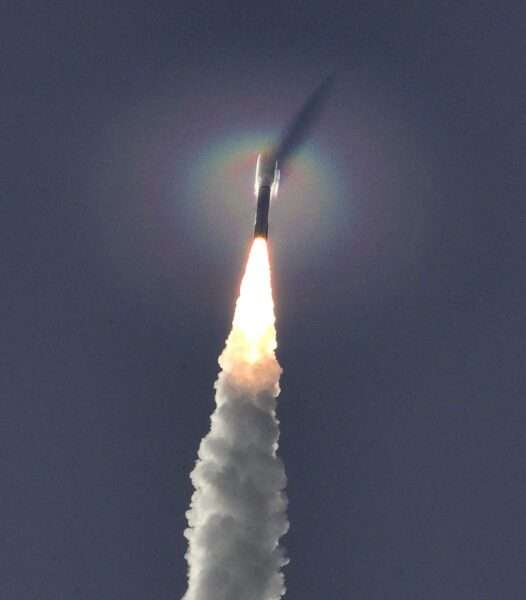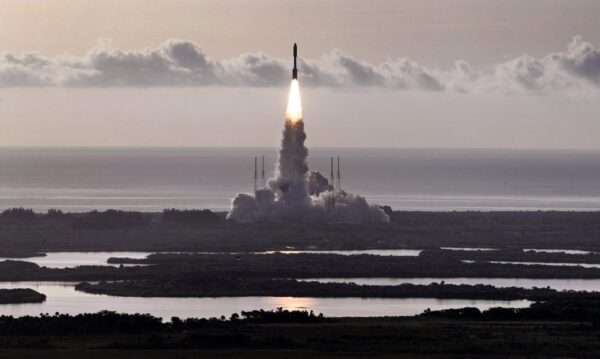America’s Mars Perseverance rover launched Thursday from Cape Canaveral, the start of an 11-year quest to find out if the Red Planet ever harbored life.
Liftoff came right on schedule at 7:50 a.m. under mostly clear skies and just a few minutes after NASA’s Jet Propulsion Laboratory in southern California reported feeling minor shakes from a small earthquake.
The $2.7 billion Perseverance mission rode atop a United Launch Alliance Atlas V rocket from Space Launch Complex 41, and if all goes well, the rover will touch down on the Martian surface in February and begin scouting out signs of ancient life. Around 8:45 a.m., the spacecraft separated from the rocket’s booster.

The United Launch Alliance Atlas 5 rocket heads oun a southbound trajectory carrying the Mars 2020 rover during lift off from Launch Complex 41 at Cape Canaveral Air Force Station, Fla., Thursday, July 30, 2020. (Joe Burbank/Orlando Sentinel/TNS)
“For me, that’s what it’s about. That question,” said Thomas Zurbuchen, NASA’s associate administrator for the science mission directorate. ” … A question that for thousands of years philosophers have asked, scientists have asked … and that is, is there life out there?”
Perseverance is one of three spacecraft that launched to Mars this summer. Two others were the Hope Orbiter from the United Arab Emirates and China’s Tianwen-1 lander and rover. They’ll build upon discoveries of past missions that found Mars could have once supported life.
The U.S launch had to be delayed three times, and if it didn’t lift off by Aug. 11, the mission would have been postponed until 2022 when there’s another window when Earth and Mars are aligned. Delaying it again would have cost NASA about $500 million.
In the lead-up to Thursday’s launch, NASA administrator Jim Bridenstine talked about the new meaning the name took on once the coronavirus began to spread across the nation.

A rainbow halo appears momentarily as the Atlas V rocket blasts through a humid layer of the atmosphere during the launch of the Mars 2020 rover from Cape Canaveral Air Force Station, Fla., Thursday, July 30, 2020. (Joe Burbank/Orlando Sentinel/TNS)
The pandemic threatened to interrupt the launch, but teams “persevered,” he said, with some working from home during the most critical points of the mission when the rover was going through final testing. The rover itself was cleaned relentlessly.
“The public wants to see the United States of America and our international partners do stunning things, and we have a history of doing amazing things in the most challenging times. And this is no different,” Bridenstine said.
Perseverance will for the first time gather rock samples that will be brought back for Earthlings to study. For the samples to make it back to Earth, America and Europe have devised a complex and lengthy return mission that will send up a yet-to-be-developed lander, rover, orbiter and small rocket.

The United Launch Alliance Atlas 5 rocket carrying the Mars 2020 rover is photographed as it lifts off from Launch Complex 41 at Cape Canaveral Air Force Station, Fla., Thursday, July 30, 2020. (Joe Burbank/Orlando Sentinel/TNS)
The hopeful return date for the samples is 2031. Only then will scientists possibly be able to determine whether anything ever lived on Mars.
As for Alexander Mather, the 13-year-old from Virginia who named the rover in a nationwide contest, he’s a believer.
“I’m not one of those people who believes in superstitious crop circles and stuff, but in my opinion, there’s so much space in the universe there’s no way we’re the only ones,” he said at a Kennedy Space Center news conference this week. “There’s got to be something or someone else out there. Even if it’s just microbes.”
Perseverance will land in Mars’ Jezero crater, a 28-mile-wide part of the planet that billions of years ago was home to a now dried-up river that could hold traces of ancient life.
“We know from other studies, other rovers and orbiters that is a key time in Mars history,” Chris Herd, a sample return scientist who works at the University of Alberta in Canada, said of the crater. “When it transitioned from being a warmer, wetter environment at the surface with nice neutral water to being more acidic waters, and then eventually drying out and rusting and turning red like we see it today.”

The United Launch Alliance Atlas 5 rocket carrying the Mars2020 rover lifts off from Launch Complex 41 at Cape Canaveral Air Force Station, Fla., Thursday, July 30, 2020. (Joe Burbank/Orlando Sentinel/TNS)
The rover is loaded with experiments, including a small helicopter named Ingenuity that will conduct the first rotorcraft flight on another planet, a modern-day “Wright Brothers moment,” NASA says.
Swatches of spacesuit materials are on board to see how they hold up on Mars, as well as a tool that can turn carbon dioxide into oxygen. Other tools will collect data about the planet’s weather to help predict dangerous dust storms and shoot a ground-penetrating laser to help figure out what kind of landing gear human missions need.
The rover’s main objective will be to drill for samples that contain possible “biosignatures” of old life, with enough tubes to hold 43 samples. Going 0.1 mph, it can self-drive 656 feet a day looking and traverse obstacles about a foot high.
To ensure the titanium sample tubes haven’t been contaminated on Earth, NASA’s planetary protection officer Lisa Pratt said they’ve been flame-sterilized and handled in ultra-clean rooms.
The rover will take photos and measurements of the samples and keep them until NASA determines the best spot to leave them on the surface. And unlike the Mars Curiosity rover that ground up rock samples and left them on Mars, these samples will be mostly whole.
Lori Glaze, director of NASA’s Planetary Science Division, said NASA will be able to preserve the samples for decades, allowing scientists in the future to study them to answer questions “we haven’t even thought of yet.”
In 2026, NASA will launch on a two-year journey a lander to bring the samples back. NASA is opting for a different and much longer route than it took for Perseverance to avoid arriving in the middle of winter when storms are prevalent.
After NASA lands back on Mars in 2028 to collect the samples, analyzing them won’t be instantaneous work. It’ll be three years until they make it to Earth, a mission NASA and the European Space Agency will work together on.
A lander will arrive on the Mars surface and with it a small NASA rocket and a European rover that will collect the sample tubes and take them back to the lander to then be transferred into a special container within the rocket.
Then in 2029, the rocket, which is only about 9 feet tall and 2 feet wide, will lift off from the Mars surface.
Meanwhile, a European orbiter also scheduled to launch in 2026 will have made its way to Mars in time for the rocket to toss over the soccer ball-sized container with the samples. The orbiter will catch it and eventually jettison it toward Earth. Both the orbiter and the fetch rover will be developed by Airbus-France.
NASA expects the samples to land in Utah no earlier than 2031.
David Parker, director of human and robotic exploration for the European Space Agency, said its portion of the return mission will total about 1.5 billion Euros, or about $1.8 billion. NASA estimated the U.S.’s part will cost up to $3 billion, but that doesn’t include the facility and all the equipment that will be needed for analyzing samples.
“We’ve always known from the very beginning that this was not going to be a simple mission where we simply fly to Mars, collect the samples and bring them back,” NASA’s Glaze said. “We’ve always known it was going to require multiple steps and multiple launches in order to actually get the samples back.”
___
(c) 2020 The Orlando Sentinel
Distributed by Tribune Content Agency, LLC.



